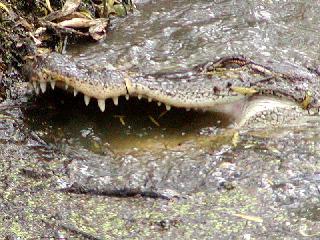 ----------
----------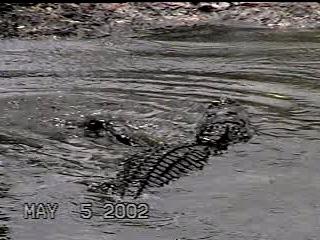
---------- ----CHOMP!-- -----COME HERE, I WON'T HURT YOU.
Most people have seen programs on television
showing crocodiles attacking large animals like deer and cattle.
While this is amazing, and sometimes horrifying, those creatures
are not alligators. The function of a crocodile's
dentition is somewhat different than an alligator's. Alligators
favor prey items that will fit inside their head. That is, if
they can
swallow it whole, then they will normally attack it. While I've
heard witnesses tell of alligators taking deer in the park, the
prey was very small fawns. Alligators have also been seen
with large nutria. But, most of the time, they will eat things
like small fish, frogs, and crayfish. Snakes and turtles are
also pursued, with alligators seeming to be especially
well-adapted for eating turtles. A recent study done in Texas
examined the stomach contents of about 50 alligators (which were
unharmed). Research showed that only one of
these alligators had eaten a bird (which couldn't be identified,
it might have already been carrion when taken), and the rest had
stomach full of small fish and shellfish. I've seen
11-foot alligators going after prey that was no larger than
their largest teeth (very small frogs and fish).
May 05, 2002
After this, I moved back towards 40-Acre lake, where I'd left my
car. At the Observation Tower, there were two alligators (about 5
to 6 feet long) that were feeding in the shallow pool
at the head of Pilant Slough. This was quite interesting, since
most of us don't often see alligators feeding. These two moved all
around the pool, and sometimes foraged directly under where
we
were standing--on the concrete wall where the floodgate was. (CHOMP!,
below)
----- ----------
----------
----------
----CHOMP!--
-----COME HERE,
I WON'T HURT YOU.
While they were foraging, I observed some very odd
behavior. Well, it looked odd, although it seemed to be
functional. The alligator would move near the shore, and suddenly
begin fanning
one of
its forelegs (wmv 2.2mb
or flv video 538kb)
and the image COME HERE,above. in a sort of "come-here" motion.
Then, it would turn its head sideways, towards the moving foot,
and grab something.
They did this often. Here are two more short clips showing
this behavior. Alligator
Fishing one (wmv
2.0mb or flv video
533kb ) Alligator
Fishing
two (wmv
757kb or flv video
288kb). Sometimes,
the alligator would be completely submerged, and then I could see
just the foreleg coming out of the water, and moving around.
I guessed that the alligators
might have been harvesting crawfish, or possibly tadpoles, but in
any case something slow enough for them to grab this way. David
Heinicke, one of the park naturalists,
thought this might be the prey as well. Looking closely at the
video, I can see lots of small fish jumping away from the
alligator. Perhaps the alligators were harvesting mouthfuls
of minnows. In one
other behavior we saw, the alligator moved backwards a few
steps, slowly swishing its tail, and then moving sideways towards
the shore. It then would hook its tail towards the shore, and do
the "foreleg
scoop", and snatch some food. I had some errands to attend to, so I had to leave
the park earlier than usual today. However, I certainly saw a lot!
UPDATE 10/18/2011--
In the 9 years since I
wrote the entry for May 05 above, I've seen alligators do
this kind of thing many times. They ARE trapping food. I
call this behavior "SEINING
". I
don't know
if anyone else has named this alligator hunting technique,
but this is what I named it. They
occasionally
do a few additional movements that make this hunting
technique even more productive. Sometimes
they will move into the deeper water (submerging if
possible), and agitate the water to flush prey. Then it
picks a bank, and works towards it. Sometimes alligators
will use their tail to cause the water to
flow, and then hunt the current. Besides converting
the original uploaded clips to wmv format, I've tried to
produce another one with a larger frame size. So, here
is the newly-edited video, from footage
shot in 2002: Demonstration
of
an Alligator "Seining" (mp4).
May 25, 2002 I
saw a little social interaction between some alligators this
morning. Before, during, and sometime after this little
event, at least one--and sometimes more-- alligators would
be hanging
around the pier, acting like delinquents, and generally being a
nuisance. At various points along the Elm Lake trail, they also
started bothering fishermen. The pictures below show one of these
alligators.
Note the jaws slightly agape (I'M JUST FLOATING)
in the first image. I've
noticed this in alligators who are hunting. This position could
also make more sense when one thinks about function of the
DPRs
(noted below). If the mouth is already open, then the grab
for food could take a bit less time. On the other hand,
depending on the size of the prey. if the jaws were closed at the
start of a quick sideways l
unge for food, then opened suddenly during the lunge, a slight
pressure difference could form which might serve to draw prey into
the mouth. This alligator seemed to be the one who preferred
this area. The
others would come by, and then leave. Look closely at WHEN HE GETS
A FISH, and you will be able to see the fishing line going into
the water. We do NOT feed the alligators at Brazos Bend Park.
Visitors
who are fishing, and attract alligators, are advised to move to
another pier, or otherwise leave the immediate area. The
alligators have the right of way in the park. If one takes your
fish or your bait, cut the
line and let him have it. Do not feed caught fish or
leftover bait to the alligators. Alligators will follow
movement in the water (see the note below) and some have learned
to associate a moving float (or bobber)
with food immediately behind it. It's generally asking for trouble
to continue fishing near an alligator. One an alligator assesses
you, and decides you are not a threat, it can become an implacable
pursuer of
what it wants. It will just "high walk" over to what it
wants and try to take it. At this point, if a human, or
anything tries to stop it, it becomes a challange. Here are
two short video clips of the delinquent at the pier.
Click on clip
one (flv video 335kb) or clip
2 (flv video 419kb). Clip one shows three alligators.
--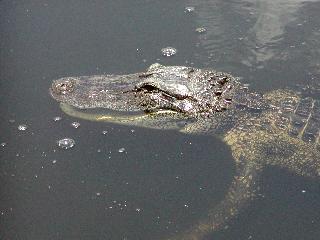 -
-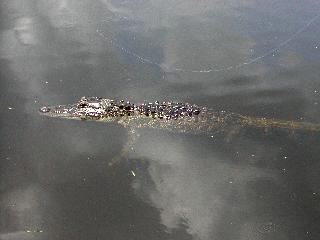 -
-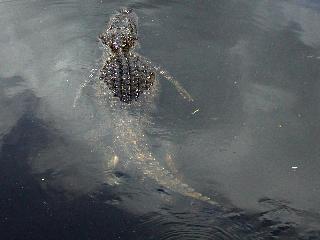
--IM JUST
FLOATING---------
---------WHEN HE GETS A FISH...---
--WHAT'S GOING ON OVER THERE?
Oh! One other
VERY COOL thing.
Evidently, the ISOs
(Integumentary Sense Organs) that I've mentioned before (see Alligators
at
Brazos Bend State Park Page 4 ) have been the subject of
recent study. I'd mentioned that these ISOs were
probably used for detection of movement in water (I read this
elsewhere, and my observations also seemed to verify it). This
recent study evidently has proven that this is the case. These
ISOs (called DPRs,
or "Dome Pressure Receptors" in the study), have been found to be
very sensitive to pressure changes in water. The researcher,
Daphne Soares, has done some very interesting work. For more
information,
try these links: NPR
radio , University
of
Maryland. I think this is pretty cool! And,
Ms. Soares has gained my admiration.
July 20, 2002 (Saturday)
I took a small group of people around the Creekfield Trail, for an
informal hike. About 3/4 of the way through, I noticed a small
(about 3 foot) alligator in the duckweed, in the shade of a
tree. As I pointed out this one, another alligator the same size
surfaced, and moved its head, as if it was eating something. While
I moved another step forward, I noticed a dead animal on the bank,
not far from
the two alligators. These alligators were, by the way, very close
to us on the trail, although they were in the water.
When I saw the dead animal--which appeared to be a small (about 4
inches long) rodent of
some kind--I couldn't really tell what it was, since all I could
really see was something dead covered in wet, grey fur. I was
about to mention the alligator behavior of keeping, and sometimes
hiding, larger prey
items so they can decay enough to tear easily, when the second
alligator started to move. This little one swam right towards us,
walked up on land, still facing us, then stopped and rested
briefly on the bank. I
thought then that it was going to sun itself, since its belly was
a bit distended.
However, it only paused a
second or so, then got back up, and walked right over to the dead
whatever-it-was. With a decisive movement of its head, it grabbed
this carrion, then lifted it; turned, and strutted back
into the water, where it began chewing on the dead animal. During
all this, I was talking in my usual dry calm tones, saying "Isn't
this GREAT? Look at that! This is SO COOL! The alligator might
have killed it! Notice
how its head is above the water. We rarely get to see this!" and
other equally inane observations, also meanwhile forgetting that I
WAS CARRYING A CAMERA. I grabbed it out of its case, turned
it on, and was
able to snap two pictures before the alligator submerged, and swam
off to feed in peace. One of these (see BREAKFAST OF REPTILES,
below) shows the alligator in the duckweed with the rat (or young
nutria,
or whatever) in its mouth. I usually am more informative in
my lectures than this. But, it was such an uncommon event!
-----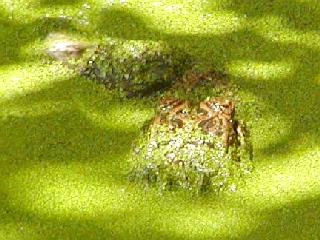 ----
-------
----
-------
RAT-BREAKFAST OF REPTILES
June 15, 2003David Heinicke, Park
Naturalist, was out on Elm Lake trail when a visitor came
running up and told him that an alligator had just seized a
turtle. He investigated, and put a call out on the radio for
people with cameras. I heard this, but could not answer (my radio
malfunctioned), so I missed this opportunity. Among the
people who witnessed this with David was John Bradford, who took
many pictures, and
even video clips with his digital camera. He generously gave me a
copy of these, and told me that I could use his material here. So,
here it is.
-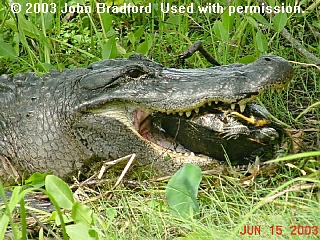 -
-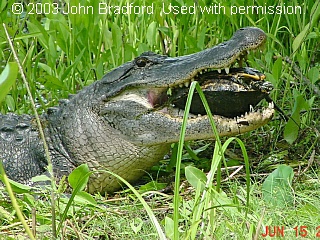 -
-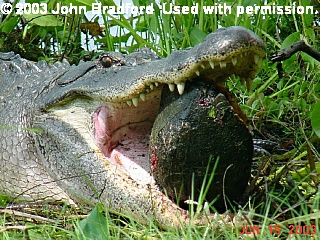 -
-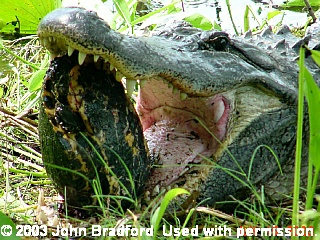 -
-
SOME
MOUTHFUL!
I CAN'T
SWALLOW *THIS*!
NOT MUCH BETTER
THIS ISN'T HELPING
The alligator took about 2
hours (yes, TWO HOURS) to reach the point where he could swallow
the turtle. Almost all of this time was expended by tossing the
turtle around until it got to a good leverage point within
the alligator's jaws. This might be similar to one of us trying to
eat a walnut without using our hands--except that we wouldn't
swallow a walnut with shells and all. This event seems, to me, to
be an excellent illustration
of the alligator's feeding strategy, as well as a good example of
the competition between predator and prey. I can't think of
any other animal in our park that could expend two hours in
pursuit of a single meal (a lot
of time that might be better used finding easier prey), and also
could even breach the turtle's defense (the shell). The turtle,
meanwhile, used its typical defense strategy--which is wait for
its attacker to give up, and/or
else scurry away. Only the alligator (as far as I know) had
the attitude and the power to get into the shell. The
alligator was eventually successful (see THE END, below), and the
turtle fell, to be swallowed whole.
The alligator can and will digest just about everything, shell
included. This alligator was at least 11 feet long, and the turtle
was quite large. This was a good stomachful for the
alligator. I warn all readers that this is
quite intense imagery, and it is not included here for
sensationalism, but as an illustration of the quiet power of the
alligator's jaws.
-----------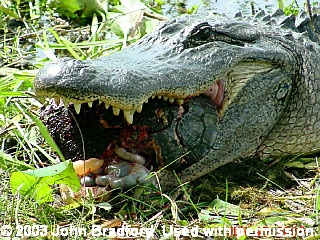
THE END
I was also interested, as
I usually am, by the leisurely pace of this event. Not only did
the alligator persevere in his quest for his meal, but he was most
languid about it, expending very little effort in movement.
This speaks again for their efficiency in using available energy
resources. The four video clips I have linked here
illustrate this better than the photos. These clips have no sound.
And, once again, I warn readers
that some of this footage may be upsetting.l As usual though, we
try to let nature run its course at the park, and sometimes this
means witnessing the death of a favored animal.
Clip1(flv video 515kb) clip3(flv video 513kb) clip3(flv video 514kb) clip4(flv video 540kb)
Thanks again to John Bradford for letting me use this rare footage.
July 13, 2003I was able to watch
some fishing, alligator-style, today. I've already shown one
style of alligator fishing on alligator
page
#6. Today's behavior was a little more exciting. The
alligators were scattered
around Elm Lake, just floating in the weeds. From time to time one
would slowly move for a yard or two, and then stop, and lie still.
Where alligators are concerned, it's sometimes difficult to tell
if one is just resting,
and watching the world; or actually hunting, and waiting for
prey. In any case, up to 30 minutes or more can go by
with almost no movement at all.
I've heard and read it often:
"Alligators are opportunistic feeders". From what I've observed,
this means that they eat whenever an opportunity presents itself
(like if some food happens to fall into their "lap"...or their
mouth, and it does, sometimes); rather than actively
hunting prey. If there are is carrion, they will eat it. If there
is small prey (sometimes no larger than the alligator's
teeth!--i.e. minnows and tadpoles) around, they will
eat it. If something a little larger (perhaps a large
mouthful-sized animal--i.e. nutria or large turtle) happens to
swim or walk in front of them while they are hungry, they will
attack it. If they are really hungry, after the
former situations haven't presented themselves (and in a healthy
habitat like the park, the former situations come up often) THEN
an alligator may go after larger, vigorous, prey.(i.e. small
deer--VERY rare occurrance)
Cannibalism of 4+ foot alligators does happen (seealligator
page
3), but this is probably due to territoriality rather than
active predation.
MOST HUMANS OLDER THAN 6
YEARS ARE NEITHER THE RIGHT SIZE NOR THE RIGHT SHAPE FOR AN
ALLIGATOR TO CONSIDER THEM AS FOOD, except perhaps as
carrion--that is, if the human is already dead.
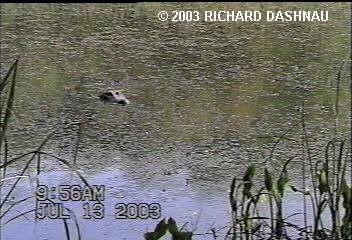 -
-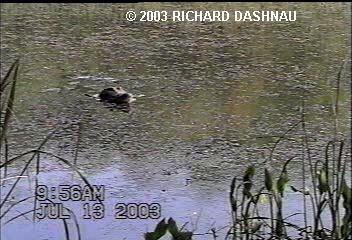 -
-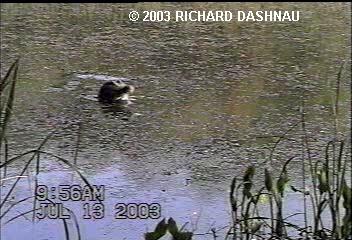 -
-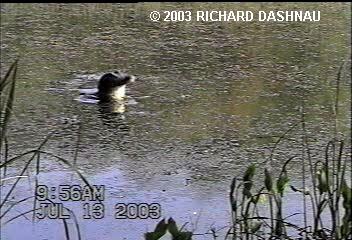 -
-
01
03
05
07
So, these alligators were
floating here and there. Suddenly, one would rear up out of
the water and do a dive (not "sounding" like a whale and
gracefully submerging, more like a twisting belly flop. I've seen
this at other
times.) After this, the alligator would surface, sometimes
chewing something. The alligators were fishing. I couldn't
see what they were fishing for, but I also saw large garfish
breaking the surface as well. The alligators
could have been chasing what the garfish were chasing, or pouncing
on the garfish. Also, I couldn't see what triggered the
jump. What decided the alligator to lunge? Was it sight? Is
it something to do with the ISO/DPRs?
After all, he's lunging at least half a body length.
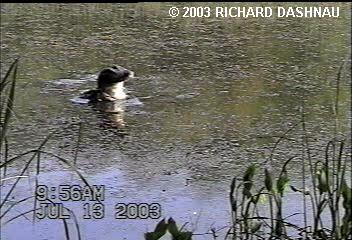 -
-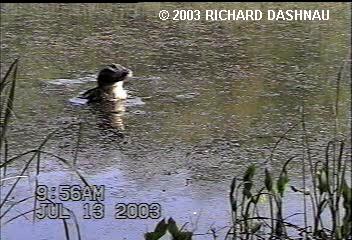 -
-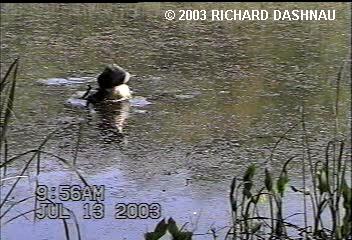 -
-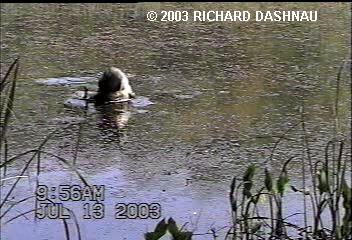 -
-
09
10
12
14
Frequently, since
alligators spend so much time being almost immobile, it can be
difficult to catch an alligator in action on film. The
immobility lulls the observer (or the prey!!) into complacency,
and then there is a sudden
movement (alligators can be very fast!), and something has
happened. Something that happened too quickly to video tape
or photograph. One finally has to just pick an
alligator, and keep recording it (if using a video
camera) and hope one gets lucky. I did this, and I got lucky! I
had to keep enough frame around the alligator to catch most of his
leap; and I had no way of knowing if he'd leap, and in
which direction. He moved towards the
camera! Today's RICKUBISCAM shows my lucky capture one of these
dives. Above and below, I have a series of frames from this
clip(remember that clicking each will show a larger image). Notice
how the alligator's
head turns sideways as it comes down. This allows it to keep an
eye on its prey, and also turns the jaws in the correct positon to
slice the water and grab whatever it was. Oh, and here is a
link to the video
clip
(flv video 290kb), and here is a link to the slow
motion
video clip (flv video 559kb).
Here's a question: How does
the alligator rear up in the first place? He's lying in water! You
try to rear up out of the water and lunge forward like this when
you are in a depth way over your head. In image number 3 and
5
we may see a hint about this. It looks like there is a sudden tail
movement just before the lunge.
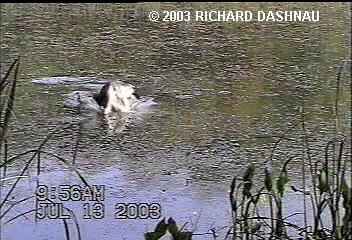 -
-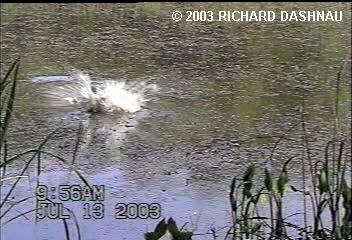 -
-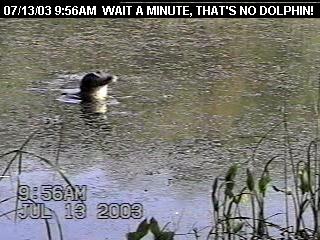
16
17
THAT'S NOT CUTE!
Go back to my main alligator page, Alligators
Go
back to my home page, Welcome to
rickubis.com
Go
to the main
alligator page